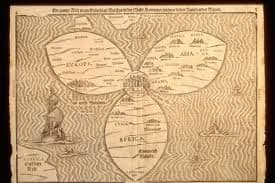
Where is the center of the Christian world? I remember having a conversation with my dad about this back in the 1980s. At the time, he was serving as the president of Moody Bible Institute in Chicago. I was studying overseas. Under his leadership, Moody was having a huge impact on the evangelical church in the United States. It was the heyday of American evangelicalism. But I said something to my dad that he did not like. Now of course, he had poured his life into Moody, and was immersed in its many ministries, so I understand his reaction. What I said was, “you know dad, Moody is not the center of the Christian world.” This was not something he really wanted to hear, and I am sure he thought his son was losing it.
Where is the center of the Christian world? Throughout church history many have offered answers to that question. At one time, the answer would have been Jerusalem (see the image attached to this post). Some time later people would have said Antioch of Syria. Later, others said Alexandria, Egypt. In the early second century some would have answered Asia Minor, where the seven churches of the book of Revelation are located. Still later the church in Rome made a claim to be the center. Then the Eastern church in Constantinople made the same claim. After that the Russian Orthodox church in Moscow made the claim. In the Middle Ages some thought Paris or London was the center. During the Reformation, I imagine Germans in Wittenberg felt that they were the center. Many refugees in Geneva gathered under John Calvin’s influence thought the same thing about their city. During the years 1554-1559 John Knox said of Calvin’s work in Geneva that “it is the most perfect school of Christ that ever was in the earth since the days of the Apostles.” Perhaps some people later made a similar claim during the Scottish Reformation about Edinburgh.
In the United States, there were moments in the American church story when Christians thought they were the center of the Christian world. When the First Great Awakening broke out in New England and the Eastern colonies, some thought the center of the Christian world was there. When the Second Great Awakening swept over Kentucky, New York and Chicago, some thought its center was there. When Billy Sunday picked up the mantle of evangelical leadership in the 1920s, some honestly thought its center was in Winona Like Indiana! When revivals broke out at Wheaton College, in Illinois some thought Wheaton, with all its nearby missions agencies, was the center. It was sometimes even referred to as” the evangelical Vatican city.” Since that time, others have claimed the same for Pasadena, California (Fuller), Colorado Springs (Focus on the Family), or Dallas, Texas (the center of all things Baptist).
Where is the center of the Christian world? Some have thought it was where their ministry was located. Was it the old Princeton or Westminster Seminary? Azusa Street in Los Angeles? Moody Bible Institute? Minneapolis, Minnesota where Billy Graham had his headquarters for years? Dallas Theological Seminary? Southern Seminary in Louisville? Masters? RTS? Is it my church, or yours?
Where is the center of the Christian world? Missiologists tell us that “the center has shifted.” Philip Jenkins, in his book The Next Christendom: The Coming of Global Christianity, reminds us that the story of Christianity has been inextricably bound up with that of Europe and European-derived civilizations overseas, above all North America. He says it was overwhelmingly white and Western. But the center of gravity in the Christian world, he says, has shifted southward to Africa and Latin America and Eastward to Asia. The largest Christian communities are to be found in Africa and Latin America. If we want to visualize a typical contemporary Christian, Jenkins says, we should think of a woman living in a village in Nigeria or in a Brazilian Favela. The centers are no longer Geneva, Rome, Athens, Paris, London, New York but Kinshasa, Buenos Aires, Addis Ababa, and Manila The center of Christian dynamism has shifted. Lausanne III recently held in Cape town, South Africa has validated much of what he says.
Christians in the West will be quick to qualify all this and say—“don’t count us out.” Even thought there is a huge decline in the European church, and a plateauing of the American church, they still exercise a powerful influence as is seen in the motivating leadership of Lausanne itself and the financial resources that flow towards missions. George Verwer, founder of Operation Mobilization told me, “If we think Christians in other nations are more trained or on target than we are in most areas, then we have got the wrong picture.” He was pointing out the need for more strong Biblical churches faithfully preaching the whole counsel of God in the global south.
There is always a danger, whether we are “the old Christendom” or the “new Christendom,” in thinking that WE are the center of dynamism in the Christian world. It is tremendously shortsighted. In so doing we overestimate how much God needs us and underestimate what God is doing elsewhere.
Where is the center of the Christian world? The truth is, although the center has shifted time and time again, it cannot be tied down to a ministry, or a city, or even a place. Christianity is a global, transnational, transcultural movement. The Word of God is not bound. That is because the center of Christianity is a person—the person of Jesus Christ, who is exalted over time and place, but who continues to make his presence known all over the earth. He will continue to do so until he comes again and the kingdoms of this world becomes the kingdom of the Lord and his Christ.
